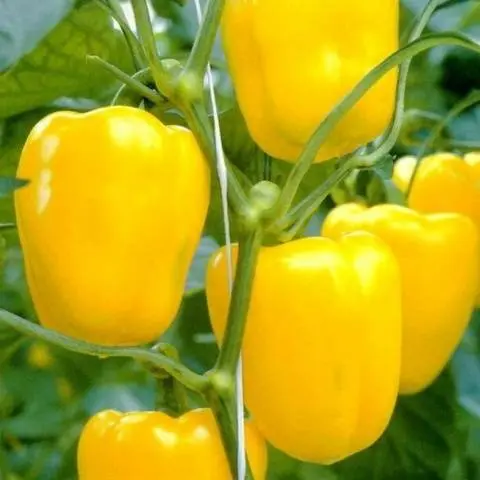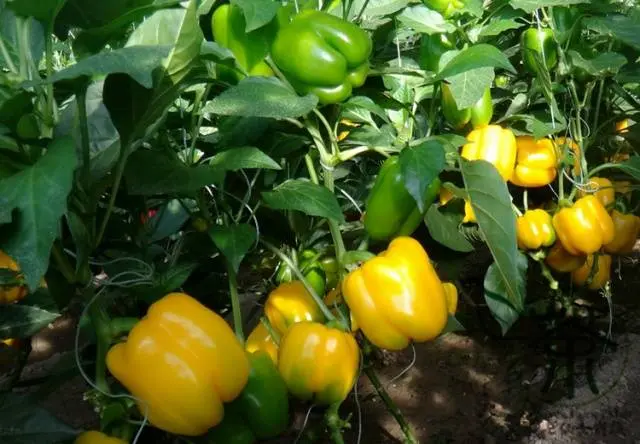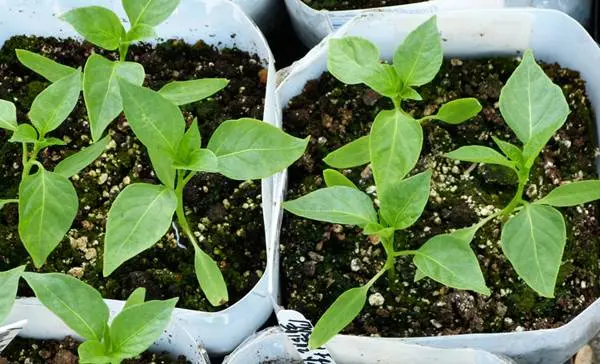Sweet bell pepper is an extremely common vegetable crop. Its varieties are so diverse that gardeners sometimes have a hard time choosing a new variety for planting. Among them you can meet not only leaders in yield, but also leaders in fruit size. The group of varieties united by the name Gigant stands out in particular. The varieties included in it have common large fruit sizes, but differ in their color and taste characteristics. In this article, we will look at the Giant Yellow sweet pepper.

Characteristic of the variety
Giant Yellow F1 is a hybrid early-maturing variety, the fruiting of which occurs in the period from 110 to 130 days. Its plants are quite powerful and tall. Their average height will be about 110 cm.
In order for them not to break during the formation of fruits, it is recommended to tie them up or use trellises.
This hybrid variety fully justifies its name. Its fruits can reach up to 20 cm in length and weigh up to 300 grams. As biological maturity approaches, the color of the peppers changes from light green to amber yellow. The pulp of the Giant Yellow variety is very dense and fleshy. The thickness of its walls is in the redistribution from 9 to 12 mm. It tastes sweet and juicy. Its application is so versatile that it is perfect even for canning.

But on the other hand, he loses to them in terms of the content of beta-carotene. This composition allows you to use this variety for those who are allergic to all red vegetables.
Giant Yellow F1 can grow with equal success in open and closed ground. The growth and fruiting of its plants does not depend on the climatic conditions of the area. The yield of the Yellow Giant will be about 5 kg per square meter. In addition, this variety of sweet pepper has excellent resistance to many diseases of this crop.
Recommendations for growing
The main guarantee of good growth and productivity of this hybrid variety is the correct choice of the landing site. Sunny areas with light fertile soils are best suited for it. If the soil in the proposed area is heavy and poorly ventilated, then it should be diluted with sand and peat. All varieties of sweet pepper are sensitive to the level of acidity – it should be at a neutral level. It will be optimal to plant plants of this crop after:
- cabbage;
- Pumpkins
- legumes;
- root crops.

Seedlings of the Giant Yellow F1 variety begin to be prepared either at the end of February or at the beginning of March. To increase the germination of seeds, it is recommended to soak them for several days in water with the addition of any growth stimulant. When preparing seedlings, one should take into account the fact that peppers do not like transplanting. Therefore, it is better to immediately plant them in separate containers. If the seeds are planted in one container, then they must be planted during the formation of the first leaf.
Giant Yellow is a rather heat-loving variety, therefore, for its seedlings, the optimum temperature will be 25 – 27 degrees during the day and 18 – 20 at night. A few weeks before planting young plants in a greenhouse or open ground, it is recommended to carry out a hardening procedure. To do this, seedlings are taken out into the street or placed near an open window. Spraying garlic, onion, calendula or marigold infusions on plants gives good results. This will allow them to gain resistance to various pests.
Giant Yellow recommends planting plants in a permanent place after 60 days from germination.
Many gardeners recommend planting young plants in a permanent place during the formation of buds. This is fundamentally wrong, because for plants, moving to a new place is stressful.
They can react to it by shedding inflorescences, which, in turn, will delay fruiting and affect the amount of the crop.
Young plants of the Yellow Giant are planted in a permanent place only after the end of spring frosts. Between neighboring plants, at least 40 cm of free space must be left. The timing of planting seedlings of this hybrid will be slightly different:
- they can be planted in greenhouses and film shelters from mid-May to mid-June;
- in open ground – not earlier than mid-June.
Caring for plants of the Giant Yellow F1 variety includes the following steps:
- Regular watering. It should be done only after the topsoil has dried and always with warm water. Watering with cold water can ruin the delicate root system of these plants. Morning watering is optimal, but evening watering is also possible. The rate of water for one bush of the Yellow Giant is from 1 to 3 liters of water, depending on the composition of the soil.
- Regular feeding. Ideally, it should be carried out three times during the entire growing season. The first time 2 weeks after planting young plants in a permanent place. The second time during the formation of buds. The third – during the formation of fruits. Any mineral or organic fertilizer is suitable for this crop. It recommends making it only under a bush, trying not to touch the leaves.Important!If the leaves of the plants of the Giant Yellow variety curl or the reverse side of the leaves acquires a purple and gray hue, then they must be additionally fed with a mineral fertilizer containing potassium, phosphorus or nitrogen.
- Loosening and weeding. Soil mulching can replace these procedures.
Plants of the Giant Yellow variety are quite tall, so it is recommended to tie them up or tie them to a trellis.
Subject to agrotechnical recommendations, the first crop of peppers of this variety can be harvested as early as July.









